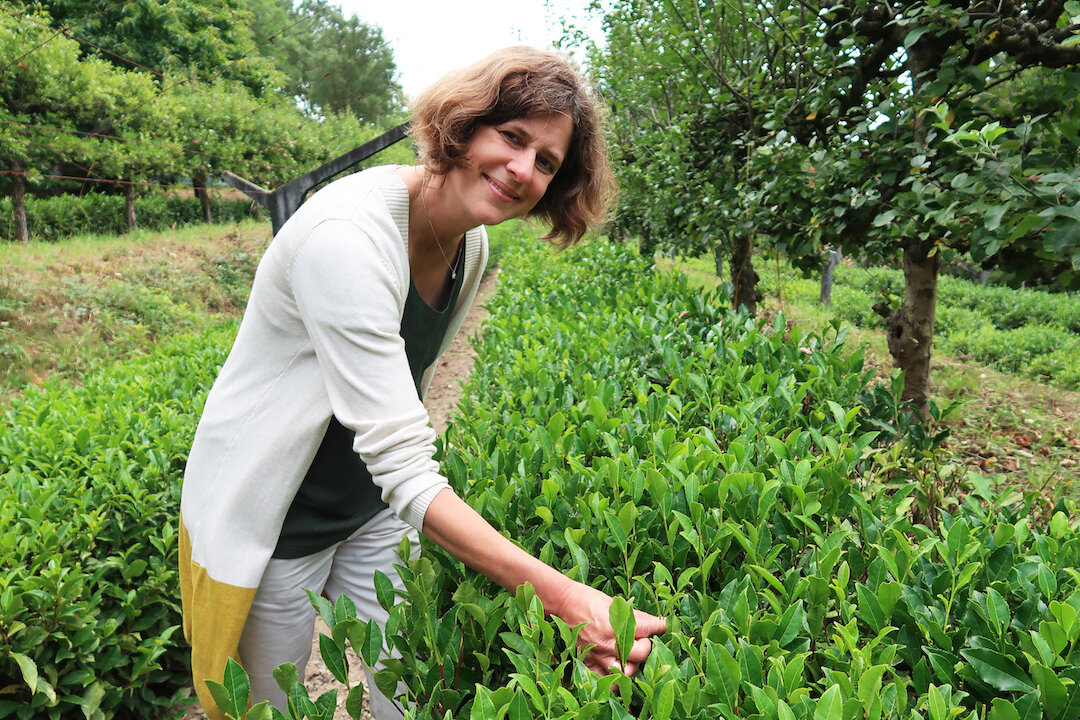What's brewing at Niepoort?
Porto-based writer James Mayor discovers a wine family's other favourite, home-grown drink.
What does a wine producer drink at tea time? In most cases the answer is easy to guess: wine, or, if not actually drinking it, tasting wine.
Portugal’s star wine producer is accustomed to thinking outside the box. Dirk Niepoort is not only an avowed tea drinker, he also owns a tea plantation. Chá Camélia is a very personal project, partnered by Dirk with his wife Nina Gruntkowski.
‘Welcome to paradise!’, Nina exclaims as I get out of the car. Nina is right, this is paradise. Chá Camélia is in Fornelo, in the Minho, the Vinho Verde wine region of Portugal, 30 minutes’ drive north of Porto. The first commercial organic-certified tea plantation in Europe, inspired by Japanese green-tea production, celebrated its debut harvest in 2019. One hectare of Camellia sinensis plants are farmed in a Garden of Eden: apple orchards, kiwis, roses and exceptionally beautiful lindens, birches, maples and oaks. ‘Forty years ago there were no trees here’, Nina explains. ‘The beauty of the place is due to Dirk’s father, Rolf.’
This part of Portugal is known as the ‘Land of Camellias’. Nina adores the location. ‘In the winter it can be grey and foggy, but we have the incredible colours of the camellia flowers. Coming from Germany I was blown over, particularly when I made the exciting discovery the tea plant is a camellia too.’
Working at the time as a radio journalist, Nina interviewed Peter Oppliger, the owner of a tea plantation on the Swiss-Italian border with a subtropical climate more aligned with Iberia. He gave Nina a tea plant to take home to Portugal. Nina and Dirk planted it in the least hospitable part of their garden, and left it to cope. To their amazement the plant survived, producing beautiful fresh leaves. ‘We learned it takes five years to get to the first harvest. But the good news is you can make every kind of tea from the same leaf.’
Dirk is a member of the fifth generation of Dutch port shippers Niepoort, who established their business in Porto in 1842. Nina, initiated to fine wine by her grandfather, tasted the best bottles from his cellar. Nina and Dirk realised they had two passions in common: wine and tea.
Nina and Dirk never drink coffee. Nina describes the couple as ‘tea fanatics’, with tea central to their lives, comparable only to their love for wine. ‘Tea structures my day, I can’t go through a day without it.’
Nina describes Chá Camélia as their ‘common child’. She is the public face of the tea brand, while Dirk is the face of Niepoort wines. Some colleagues initially considered the project eccentric. ‘The reaction was why make tea in Portugal, when you can make wine!’
Sharing a deep interest in Asian cultures, Nina and Dirk regularly visit Japan. In 2012 they began distributing Morimoto family teas and other small Japanese family producers. ‘The Morimotos were amazed Europeans could be so interested in growing tea.’ They became friends and over the years generously offer experience and advice. ‘We started the Chá Camélia project in the middle of the economic crisis, a particularly difficult time for Portugal. We’re beginning to gain traction now and, when you explain to people leaves can be used several times, tea appears good value compared to wine.’
It may seem ironic that the first continental European organic green-tea plantation is located in Portugal. Most Portuguese are committed coffee drinkers, popping into a café several times a day for an espresso shot, sometimes accompanied by a sweet, eggy cake. However, a Portuguese royal princess, Catarina de Bragança, packed tea in her trunks to sail to England to marry Charles I in 1662. No doubt insurance against the dreary English weather!
Nina remembers offering a Portuguese friend tea, to receive the retort, ‘I’m not English!’ With Asian tea plantations a very long sea voyage away, tea remained a drink for the wealthy, until the advent of faster clippers and steamships permitted a gradual democratisation of consumption.
As the market grew it divided between industrial tea (‘builder’s tea’, when drunk with milk and sugar in the UK), blended from many different plantations with scarcely a nod to the notion of terroir, and fine tea, grown on a single plantation, the equivalent of single-estate wine.
For centuries tea has been drunk by Buddhist monks to improve concentration during meditation. ‘People who visit Chá Camélia for our workshops really appreciate the slower pace. This is very precious in our Western societies and contrasts with the more speedy coffee culture.’ Nina reports interest in tea is growing as people become more interested in healthy and relaxed lifestyles. ‘I think there is a great future for a beverage which enhances focus and calm.’
And artisanally produced green tea, such as that made by Chá Camélia, is purported to have many beneficial qualities that may contribute to our wellbeing: vitamins C and K, and tannins that produce antioxidant effects linked to cancer prevention.
Nina Gruntkowski with James Mayor at Chá Camélia
Cultural attitudes determine the way tea is consumed. In the West we have traditionally paired tea with cake, at ‘tea time’, generally considered to be around five o’clock. In Asia, drinking tea is an all-day affair, and tea more often drunk with savoury or salty foods than with sweets, to accompany an entire meal or any hour of the day. ‘We encourage people to drink tea the Asian way, in different situations, with salty foods, or on its own.’
Nina is welcoming, softly spoken, calm. She confesses to being a ceramic ‘addict’ with a collection of tea ceramics, and one day hopes to create her own. She is interested in calligraphy and learning Japanese. Considering Nina’s mastery of Portuguese, I expect she’ll get there soon.
Chá Camélia’s refined packaging has a Japanese aesthetic. The brand’s red logo, inspired by Asian stamps, reminds me of a quality seal.
A loud ringing rips through the afternoon peace, momentarily drowning Nina’s voice. ‘Oh there’s the transporter to pick up some shipments.’ Chá Camélia has a growing network of organic shops, wine outlets and restaurants which sell their teas throughout Portugal. At chef Rui Paula’s Casa de Chá da Boa Nova, on the shores of the Atlantic near Porto and one of the most perfect restaurants I know, a tasting menu is paired with their Nosso Chá. Gradually, more sommeliers are getting interested in tea.
Chá Camélia is certified organic and strictly follows biodynamic principles. ‘We try to avoid buying things from outside the farm. Our teas are shipped in recycled Niepoort wine boxes. I grew up with the Green Movement in Germany and my parents always recycled. This is both philosophical and practical, you need to value what you already have.’
‘At harvest time, we begin picking by hand at eight in the morning. By mid-morning we start on production.’ The tea is dry by late afternoon and ready to taste, even though additional flavours will evolve over the coming weeks. A garage once used to house Rolf’s vintage car collection has been renovated to contain tea-processing machinery.
Every day a different batch of tea is picked. At the end of the spring harvest all batches are tasted and selections made for the Nosso Chá house blend. The most exceptional batches are put aside for stand-alone consumption.
The first infusion contains the most caffeine, the caffeine content decreasing with each subsequent infusion. ‘From the second infusion onwards, you can enjoy all the benefits of green tea without a massive caffeine shot’, comments Nina. Each brewing also tastes slightly different, just as the taste of a wine evolves once a bottle is opened and the wine comes in contact with oxygen.
A tea’s quality is determined by the season and time of picking. Tea from a spring harvest is the most precious, with the finest leaves, offering after winter dormancy freshness and the most complex flavours. By the autumn, the quality decreases: ‘we don’t do an autumn harvest, to give the plants a chance to rest’, Nina comments.
Each tea has its moment. A spring tea might be ideal to wake you up – ‘don’t speak to me before my first tea!’ Nina exclaims – whereas a summer flush, with lower caffeine content, might be more suited for later in the day. I make a mental note to text Nina: ‘Nina, it’s 3 pm, what do I drink now?’
In a tea-tasting ritual aesthetics are everything. Water temperature should be below boiling point – around 70 °C is ideal – and the quality of the water is all important: bottled or filtered water is recommended. Each brewing tastes a little different.
Three teas
Kintsugi Chá
Light green colour, fresh and brilliant. Explodes in the mouth, slight sweetness with shellfish (we are close to the Atlantic Ocean) and tannins. Long harmonious finish. After a few minutes, the tea begins to open up, gaining in seaweediness and complexity. Nina says the second or third brewing is usually the most perfect.
Nosso Chá
The brand’s principal green tea is handmade with leaves from the first hand-picked harvest. Saline maritime notes, lychees, complex and lengthy finish. Three or four infusions can be made.
Pipachá
Nina and Dirk have connected their two worlds, wine and tea, in an original tea creation. Inspired by a South Korean producer ageing tea in cedar-wood boxes, Pipachá is matured for six months in port-wine barrels. Apparently, no other producer, anywhere, ages their tea in wine barrels! The oolong tea (selected by Nina and Dirk though not grown in Portugal) picks up flavours from the used wood, which has absorbed port for decades. The old barrels are no longer oaky and when we taste the tea, port is present on the nose and in the gentle, generous finish. Dirk, cheekily, has circumvented the elaborate regulations of the Instituto dos Vinhos do Douro e Porto (IDVP), introducing the word generoso on the label – in Portuguese a vinho generoso is a fortified wine and pipa a cask for ageing.
Wine and tea production
I ask Nina to pinpoint some of the similarities and differences between wine and tea production. Here are her answers.
Similarities: the importance of topography and climate, different plant varieties, particularly terroir and deep-rooted cultural production processes.
Differences: there are many months before wine reaches the bottle during which the winemaker can accompany the wine and correct faults. With tea you have to be very alert so the leaves don’t oxidise. Once the tea is ready, there’s still evolution, but it’s a much shorter time span.
This leads us to a fascinating question, particularly from a winemaking perspective: is tea suitable for ageing? ‘We know dark tea can be aged for decades’, Nina states. ‘The current thinking with green tea is to drink it as young and fresh as possible. However, we know a Japanese producer who is ageing green tea… We’re fans of vacuum packaging, to retain the quality. I can’t give you the answer yet. For now, ageing is an open subject.’
‘It’s complex to produce a high-quality green tea. For the time being we’re concentrating on green only. Later, I would love to produce oolong.’
Perhaps unsurprisingly, Nina and Dirk have not heard of any other wine producers also producing tea…
Chá Camélia receives small groups of visitors by appointment, for tastings or workshops.
Originally published in JancisRobinson.com, August 2021




